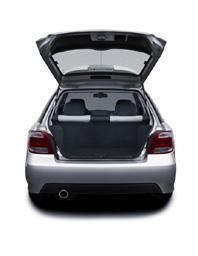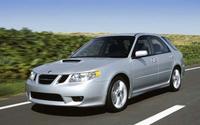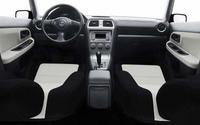New Car Review: 2005 Saab 9-2X
 |
DRIVING DOWN THE ROAD WITH CAREY RUSS
Saab, at the moment, is one of the ``other'' European premium brands, and probably not the one that comes to mind for most people when asked to name a European sport-luxury car maker.
Saab would like to change that, and is succeeding. Sales were at record levels last year, and Saab is currently the fastest-growing premium brand. Saab wants to keep that momentum and even expand into new markets. In particular, since the average Saab sold today is priced out of the reach of many young potential Saab enthusiasts, Saab has been looking for a way to enter the soon-to-explode premium (but still reasonably-priced) sport-compact class. That they soon will do, with the new Saab 9-2X.
A few years ago, when Saab Automobiles was an independent entity, expansion would have been difficult. Capital for expansion was minimal, and the product line was small. Then General Motors stepped in and bought controlling interest in the automobile part of Saab, separating it from the aircraft business and Scania trucks.
Despite the initial misgivings of some industry observers, including myself, this has been a great benefit to both Saab and GM, giving Saab access to platforms and engines from GM, and giving GM access to Saab safety technology. And the cars that have resulted are still undeniably Saabs - the ``platform'' - chassis stampings and basic suspension design - under the 9-3 may be shared with that under the Chevrolet Malibu, but no one will ever confuse the two cars.
Besides, from an historical standpoint, platform-sharing with other manufacturers is nothing new to Saab. The platform under the 1990s 9000 was developed in a short-lived joint venture between Saab and Fiat. The only Italian fruit of that project to reach America was the Alfa Romeo 164. You never would have known of any similarities by looking at or driving the cars, as they looked and felt completely different.
So now, from the great worldwide General Motors parts bin comes the 2005 Saab 9-2X. Totally unlike any Saab ever to come before, it's the first Saab with all-wheel drive instead of front-wheel drive. It is the first Saab with a ``boxer'' flat-four cylinder engine. And it's the first Saab to be made not in Sweden, but in Japan. If boxer engine, all-wheel drive, and Japan add together in your brain to ring bells of recognition, congratulations! For, like Saab, Subaru is a part of the far-flung General Motors empire - GM owns a 20 percent stake in Subaru's parent, Fuji Heavy Industries - and when Saab went shopping for a car in the GM catalog upon which to base the 9-2X, it picked the Subaru Impreza wagon.
This was definitely a good pick. The Impreza and its WRX offshoot have a fine reputation, and the WRX has made Subaru a major contender in the sport-compact class. In size and proportion, the Impreza wagon is more of a five-door hatchback than a wagon, and Saab has a long, proud history with three- and five-door hatchbacks. Best, while both Saab and Subaru enjoy enthusiastic followings, and are most popular in the same parts of the country, there is, according to Saab spokespeople, little cross-shopping between the two. So Saab won't be stepping on any Subaru toes. But can something as distinctive and idiosyncratic as a Subaru Impreza be used to make a Saab? Would the 9-2X be merely, excuse the irresistible pun, a ``Saabaru''?
With these and other questions in mind, I recently journeyed to San Diego, California for the press launch of the Saab 9-2X, which should be on sale by the beginning of June in North America.
There will be two 9-2X models, both named in keeping with current Saab convention. The Linear will be the base model. While not as luxuriously-equipped as a 9-3, it is above the run-of-the-mill sport-compact in appointment. The premium model is the Aero, with more power and standard equipment. Prices have been announced as $22,990 base for the Linear and $26,950 for the Aero. Add a $695 destination charge to that, plus options, and they are still less than any 9-3.
The 9-2X will be marketed to young or at least young-at-heart people who couldn't afford a 9-3. With the customers' projected income, it is quite likely to be an only car, so, along with style and performance, versatility is important. For a ``do everything'' car, a five-door hatchback is ideal, with its inherent cargo and passenger space and ease of access, and the 9-2X promises performance and refinement in addition to its practicality.
My first impression upon seeing the car was that it absolutely looks like a Saab, inside and out. It shares only the roof, doors, and rear fender panels with its ``donor car.'' Appropriate to its place in the Saab lineup, the 9-2X is smaller in every dimension than the 9-3, but still has plenty of room for young singles or families. The three-port grille, wraparound headlight treatment, and flat hood are pure Saab, developments of styling themes that go back twenty years or more.
The Aero has a functional hood scoop, but it is less pronounced than that of the WRX. Rear styling is also undeniably Saab, with different taillights than the Impreza and a blackout treatment to the D-pillars that gives the rear glass a wraparound look and emphasizes kinship to other Saab wagons. Interestingly, although the C-pillars are identical to those of the Impreza, they are very, very close in shape to those of the Saab 9-5 wagon. Parallel evolution?
Inside, the 9-2X has gotten the Saab treatment as well. The interior panels have a Swedish Modern design that is not found in the Subaru, for an airy, spacious look. The instrument panel has been restyled, with a larger hood over the instruments. Those instruments come from the Saab catalog, not Subaru. Although the center stack is mighty familiar in shape, the plastic material has been toned down a touch. The Linear's climate controls are similar to the Impreza's; the Aero gets automatic controls. The climate control systems in both models are also from Saab - the mountains east of San Diego get very warm in the springtime, but Saab's air conditioning gives ``instant Sweden.'' And Saab has improved upon the already very good WRX seats. A split folding rear seat and the five-door hatchback design make for plenty of useful space when needed, and two real people can fit in the rear seat.
This is not the first time a ``foreign'' engine has been found in a Saab. When the original Saab two-stroke triple succumbed to emissions laws in the late 1960s, a German Ford V4 found its way into the Saab 96. At this point, the 9-2X engines are unchanged from Subaru spec. Both are, of course, horizontally-opposed four-cylinder designs, with a five-speed manual gearbox standard and a four-speed automatic optional. And all-wheel drive is standard fare as well. The Linear has the Impreza's 2.5-liter naturally-aspirated engine, with 165 horsepower at 5,500 rpm and 165 lb-ft of torque at 4,000 rpm. The Aero gets the 2.0-liter turbocharged and intercooled WRX engine, with 227 horses at 6,000 rpm and 217 lb-ft of torque at 4,000 rpm.
Although the basic chassis is the same as the Impreza and WRX, Saab has given it a Swedish massage. The WRX in particular is a little rough around the edges, light on soundproofing and with a suspension that is aimed at performance more than comfort. This is exactly right for the rally-car-for-the-road WRX.
Saabs are more refined, but still should be capable of sport-level handling. And so Saab's engineers have reworked the suspension tuning and geometry, and replaced some of the steel suspension links with aluminum. Redesigned engine mounts decrease transmitted noise and vibration, as do additional soundproofing materials. Four-wheel antilock discs are standard, and safety equipment includes active head restraints for front passengers and front and front side and thorax air bags.
But how is it on the road, you ask? To find out, I spent a long day driving the sinuous backroads of Eastern San Diego County and the much straighter and more-crowded freeways in the San Diego metropolitan area. The day ended at a beach venue where an autocross course was set up. I spent most of the day in a manual-transmission Aero, with time later in an automatic Linear, and tried both on the autocross.
Verdict? Lovely car in either trim, with plenty of useable power and a degree of refinement not expected in the sport-compact class. And it feels like any other Saab on the road, with an excellent balance of comfort and handling. Road noise levels are closer to what is expected in an $35,000 car than in the $25,000 class. When pushed hard between the autocross cones, both varieties were great fun, with confidant all-wheel drive traction and nimble handling. Softening the suspension a touch has not given up any handling prowess, especially in everyday conditions.
Saab has a winner in the 9-2X, and it should keep sales momentum rolling and bring the Saab experience to a new group of drivers.
SPECIFICATIONS 2005 Saab 9-2X
Base Price $22,990 Linear, $26,950 Aero
Engine Type: Horizontally-opposed four-cylinder
Linear: single overhead cam, 2.5-liters (150 cu. in.) displacement 165 hp @ 5500 rpm; 166
lb-ft @ 4000 rpm
Aero: dual overhead cam, 2.0 liters (122
cu.in.) displacement, turbocharged and intercooled 227 hp @
6000 rpm; 217 lb-ft @ 4000 rpm
Transmission 5-speed manual standard, 4-speed electronically-controlled automatic optional
Wheelbase / Length 99.4 in. / 175.6 in.
Fuel Capacity 15.9 gal.
Brakes, front/rear vented disc / solid disc, ABS and EBD
standard
Suspension, front/rear independent MacPherson strut /
independent dual-link strut
Drivetrain front engine, all-wheel
drive
EPA Fuel Economy - miles per gallon city / highway
Linear: 22/29 Aero: 20/26




